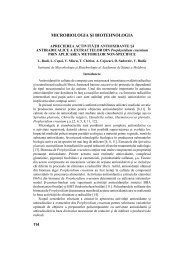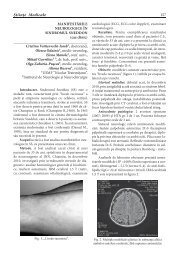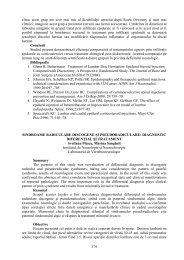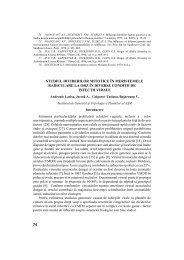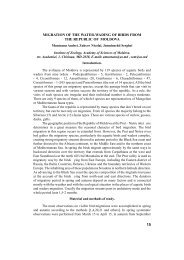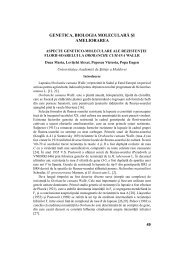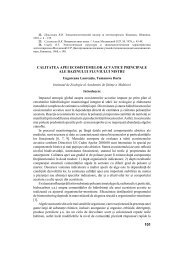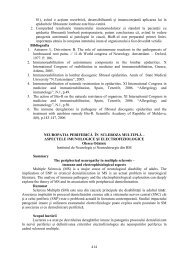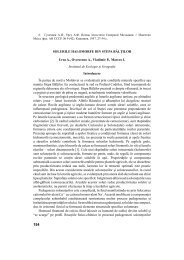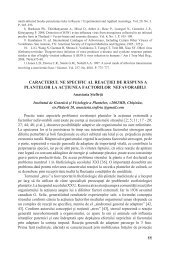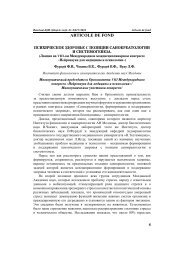198 CUPRINS
198 CUPRINS
198 CUPRINS
You also want an ePaper? Increase the reach of your titles
YUMPU automatically turns print PDFs into web optimized ePapers that Google loves.
crenatus Corbett 1966 (Gr, Ap, Sb), P. curvitatus Van der Linde 1938 (Gr, Ap, Pe,<br />
Bc), P. hamatus Thorne & Allen 1950 (Gr, Ap, Pe, Bc, Rb), P. microdorus Andrássy<br />
1959 (Gr, Sb), P. nanus Cobb 1923 (Gr, Ap, Pe), P. tenuicaudatus Wu 1961 (Ap),<br />
P. veruculatus Wu 1962 (Ap); family Neotylenchidae: Deladenus durus (Cobb<br />
1922) (Sb); family Psilenchidae: Psilenchus aestuarius Andrássy 1962 (Gr, Sb), P.<br />
aberrans Thorne 1949 (Ap), P. hilarulus de Man 1921 (Ap); family Telotylenchidae:<br />
Amplimerlinius macrurus (Goodey 1932) (Gr), Bitylenchus dubius (Bütschlii 1873)<br />
(Gr, Ap, Pe, Sb), B. parvus (Allen 1955) (Bc), Merlinius brevidens (Allen 1955) (Gr,<br />
Ap, Sb), Tylenchorhynchus cylindricus Cobb 1913 (Gr, Ap, Pe, Bc, Rb), T. elegans<br />
Siddiqi 1961 (Sb); family Hoplolaimidae: Helicotylenchus digonicus Perry 1959<br />
(Gr), H. dihystera (Cobb 1893) (Gr, Ap, Pe, Gb, Sb), H. crenatus Das, 1960 (Gr, Pe,<br />
Bc, Rb), H. erythrinae (Zimmermann 1904) (Gr, Bc, Gb, Sb), H. multicinctus (Cobb<br />
1893) (Gr, Ap, Pe, Bc, Rb, Gb, Sb), H. varicaudatus Yuen 1964 (Gr), H. vulgaris<br />
Yuen 1964 (Gr, Ap, Pe, Bc, Rb, Gb, Sb), Rotylenchus agnetis Szczygiel 1968 (Gr,<br />
Ap, Pe, Bc, Rb, Gb, Sb), R. incultus Sher 1965 (Gr, Ap, Pe, Bc), R. robustus (de Man<br />
1876) (Gr); family Pratylenchidae: Pratylenchoides crenicauda Winslow 1958 (Gr,<br />
Pe, Sb), P. leiocauda Sher 1970 (Ap, Pe), Pratylenchus brachyuris (Godfrey 1929)<br />
(Gr, Ap), P. neglectus (Rensch 1924) (Gr, Gb, Sb), P. penetrans (Cobb 1917) (Gr, Ap,<br />
Pe, Bc, Rb), P. pratensis (de Man 1880) (Gr, Ap, Pe, Bc, Rb, Gb, Sb), P. subpenetrans<br />
Taylor & Jenkins 1957 (Gr, Sb); Pratylenchus sp.1 (Gb), Pratylenchus sp. 2 (Gb,<br />
Sb); family Ecphyadophoridae: Lelenchus leptosoma (de Man 1880) (Gr, Ap, Pe,<br />
Sb); family Anguinidae: Ditylenchus brevicauda (Micoletzky 1925) (Sb), D. dipsaci<br />
(Kühn 1857) (Gr, Ap, Pe, Bc, Rb, Gb, Sb), D. intermedius (de Man 1880) (Gr, Sb),<br />
D. minutus Husian et Khan, 1967 (Gr, Ap), D. triformis Hirschmann & Sasser 1955<br />
(Gr, Pe), Nothotylenchus acris Thorne 1941 (Gr, Ap, Bc, Rb, Gb), N. acutus Khan<br />
1965 (Gr, Ap); family Tylenchidae: Aglenchus agricola (de Man 1884) (Gr, Ap, Pe,<br />
Bc, Rb, Gb, Sb), Basiria aberrans (Thorne 1949) (Ap), Boleodorus impar Khan &<br />
Basir 1964 (Ap, Sb), B. thylactus Thorne 1941 (Ap, Pe, Bc, Rb, Gb, Sb), Coslenchus<br />
costatus (de Man 1921) (Gr, Ap, Rb), Filenchus liformis (Bütschli 1873) (Gr, Ap, Pe,<br />
Bc, Rb, Gb, Sb), F. misellus (Andrássy 1958) (Gr, Bc, Rb, Gb, Sb), F. orbus (Andrássy<br />
1954) (Ap, Bc), F. sandneri (Wasilevska 1965) (Ap), F. thornei (Andrássy 1954) (Ap,<br />
Sb), Malenchus exiguus (Massey 1969) (Bc, Rb, Sb), M. fusiformis (Thorne & Malek<br />
1968) (Sb), Tylenchus davainei Bastian 1865 (Gr, Ap, Pe, Bc, Rb, Gb, Sb), T. elegans<br />
de Man 1876 (Gr), T. minutus Cobb 1893 (Gr, Ap, Pe, Gb, Sb), T. striatus (Das, 1960)<br />
Meyl, 1960 (Pe, Bc, Rb).<br />
The trophic structure of plant parasitic nematode communities were studied for<br />
the different types of plantations according the feeding groups by Yeates et al. [9]. The<br />
ectoparasite species (28,6 – 48,6 % from total number of species) were predominated<br />
in all studied communities (Table 1).<br />
Abundance of nematodes including the free-living and plant parasitic nematodes at<br />
the soil pro les 0 – 20 cm were 503 – 2640 individs/100 g soil in the vineyards, 327 –<br />
2461 individs/100g soil in the orchards of apple, 264 - 1144 individs/100 g soil in the<br />
orchards of peach, 570 – 1380 individs/100g soil in the plantations of strawberry, 787<br />
– 1120 individs/100g soil in the plantations of black currant, 720 - 1140 individs/100g<br />
soil in the plantations of raspberry and 680 - 1200 individs/100g soil in the plantations<br />
89



